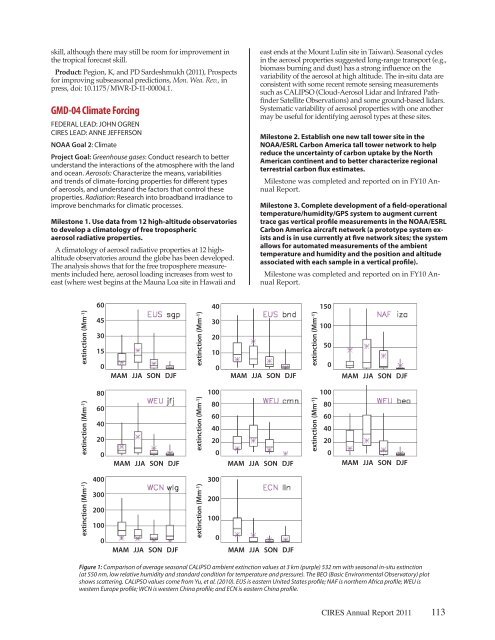2011 - Cooperative Institute for Research in Environmental Sciences ...
2011 - Cooperative Institute for Research in Environmental Sciences ...
2011 - Cooperative Institute for Research in Environmental Sciences ...
Create successful ePaper yourself
Turn your PDF publications into a flip-book with our unique Google optimized e-Paper software.
skill, although there may still be room <strong>for</strong> improvement <strong>in</strong><br />
the tropical <strong>for</strong>ecast skill.<br />
Product: Pegion, K, and PD Sardeshmukh (<strong>2011</strong>), Prospects<br />
<strong>for</strong> improv<strong>in</strong>g subseasonal predictions, Mon. Wea. Rev., <strong>in</strong><br />
press, doi: 10.1175/MWR-D-11-00004.1.<br />
GMD-04ClimateForc<strong>in</strong>g<br />
FEDERAL LEAD: JOHN OGREN<br />
CIRES LEAD: ANNE JEFFERSON<br />
NOAA Goal 2: Climate<br />
Project Goal: Greenhouse gases: Conduct research to better<br />
understand the <strong>in</strong>teractions of the atmosphere with the land<br />
and ocean. Aerosols: Characterize the means, variabilities<br />
and trends of climate-<strong>for</strong>c<strong>in</strong>g properties <strong>for</strong> different types<br />
of aerosols, and understand the factors that control these<br />
properties. Radiation: <strong>Research</strong> <strong>in</strong>to broadband irradiance to<br />
improve benchmarks <strong>for</strong> climatic processes.<br />
Milestone 1. Use data from 12 high-altitude observatories<br />
to develop a climatology of free tropospheric<br />
aerosol radiative properties.<br />
A climatology of aerosol radiative properties at 12 highaltitude<br />
observatories around the globe has been developed.<br />
The analysis shows that <strong>for</strong> the free troposphere measurements<br />
<strong>in</strong>cluded here, aerosol load<strong>in</strong>g <strong>in</strong>creases from west to<br />
east (where west beg<strong>in</strong>s at the Mauna Loa site <strong>in</strong> Hawaii and<br />
ext<strong>in</strong>ction (Mm -1)<br />
ext<strong>in</strong>ction (Mm -1)<br />
ext<strong>in</strong>ction (Mm -1)<br />
60<br />
45<br />
30<br />
15<br />
0<br />
80<br />
60<br />
40<br />
20<br />
0<br />
400<br />
300<br />
200<br />
100<br />
0<br />
MAM JJA SON DJF<br />
ext<strong>in</strong>ction (Mm -1)<br />
100<br />
80<br />
60<br />
40<br />
20<br />
0<br />
MAM JJA SON DJF MAM JJA SON DJF<br />
MAM JJA SON DJF<br />
ext<strong>in</strong>ction (Mm -1)<br />
ext<strong>in</strong>ction (Mm -1)<br />
40<br />
30<br />
20<br />
10<br />
0<br />
300<br />
200<br />
100<br />
0<br />
east ends at the Mount Lul<strong>in</strong> site <strong>in</strong> Taiwan). Seasonal cycles<br />
<strong>in</strong> the aerosol properties suggested long-range transport (e.g.,<br />
biomass burn<strong>in</strong>g and dust) has a strong <strong>in</strong>fluence on the<br />
variability of the aerosol at high altitude. The <strong>in</strong>-situ data are<br />
consistent with some recent remote sens<strong>in</strong>g measurements<br />
such as CALIPSO (Cloud-Aerosol Lidar and Infrared Pathf<strong>in</strong>der<br />
Satellite Observations) and some ground-based lidars.<br />
Systematic variability of aerosol properties with one another<br />
may be useful <strong>for</strong> identify<strong>in</strong>g aerosol types at these sites.<br />
Milestone 2. Establish one new tall tower site <strong>in</strong> the<br />
NOAA/ESRL Carbon America tall tower network to help<br />
reduce the uncerta<strong>in</strong>ty of carbon uptake by the North<br />
American cont<strong>in</strong>ent and to better characterize regional<br />
terrestrial carbon flux estimates.<br />
Milestone was completed and reported on <strong>in</strong> FY10 Annual<br />
Report.<br />
Milestone 3. Complete development of a field-operational<br />
temperature/humidity/GPS system to augment current<br />
trace gas vertical profile measurements <strong>in</strong> the NOAA/ESRL<br />
Carbon America aircraft network (a prototype system exists<br />
and is <strong>in</strong> use currently at five network sites; the system<br />
allows <strong>for</strong> automated measurements of the ambient<br />
temperature and humidity and the position and altitude<br />
associated with each sample <strong>in</strong> a vertical profile).<br />
Milestone was completed and reported on <strong>in</strong> FY10 Annual<br />
Report.<br />
MAM JJA SON DJF<br />
MAM JJA SON DJF<br />
Figure 1: Comparison of average seasonal CALIPSO ambient ext<strong>in</strong>ction values at 3 km (purple) 532 nm with seasonal <strong>in</strong>-situ ext<strong>in</strong>ction<br />
(at 550 nm, low relative humidity and standard condition <strong>for</strong> temperature and pressure). The BEO (Basic <strong>Environmental</strong> Observatory) plot<br />
shows scatter<strong>in</strong>g. CALIPSO values come from Yu, et al. (2010). EUS is eastern United States profile; NAF is northern Africa profile; WEU is<br />
western Europe profile; WCN is western Ch<strong>in</strong>a profile; and ECN is eastern Ch<strong>in</strong>a profile.<br />
ext<strong>in</strong>ction (Mm -1)<br />
ext<strong>in</strong>ction (Mm -1)<br />
150<br />
100<br />
50<br />
0<br />
100<br />
80<br />
60<br />
40<br />
20<br />
0<br />
MAM JJA SON DJF<br />
MAM JJA SON DJF<br />
CIRES Annual Report <strong>2011</strong> 113
















